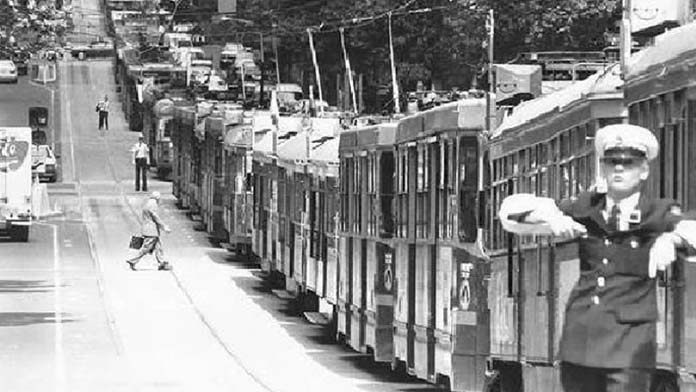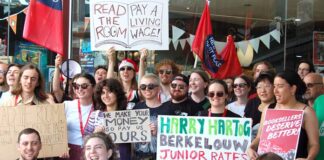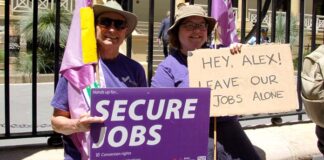When Labor turned on them in 1990, Melbourne tram workers fought job cuts through occupying their depots and taking control of the transport system, writes David Glanz
With all mainland governments now led by Labor, how will unions react over jobs, pay and conditions?
We’ve already seen unions pull their punches for the ALP. In Victoria, the teachers’ union rammed through a pay deal of just 1.7 per cent early last year to help clear the decks for the state election.
In NSW, unions paused strikes by teachers and nurses in order to put organising efforts behind Labor’s election campaign.
But with the possibility of recession looming, those same Labor governments can turn on their supporters. In Victoria, the Andrews government is already demanding public service departments find cuts of 10 per cent, likely to lead to the loss of 6000 jobs.
That’s why it’s important to look back on times when workers have taken on Labor governments in a fight for jobs.
In 1990, tram workers in Melbourne fought the Cain Labor government for 33 days, blockading the city centre with 250 trams and occupying their depots.
Workers took a stand to save the jobs of conductors, the men and women who sold tickets onboard and looked out for passenger safety.
Their heroic struggle was ultimately undermined by union officials more scared of the law than of job losses. But conductors stayed on Melbourne trams for another eight years.
Debt crisis
The situation in the late 1980s was eerily similar to today, with governments accumulating large debts, a rolling crisis in the financial sector and a looming recession (which finally hit in September 1990).
In October 1987, an international stock market slump saw markets crash around the world. In Australia, shares fell 40 per cent.
The financial turmoil put the Cain government under enormous pressure. In 1988 the Victorian Economic Development Corporation was declared insolvent at a loss to the government of some $112 million.
Tricontinental, the merchant subsidiary of the Victorian State bank, went bust in May 1989, adding another $1.7 billion to the Victorian government’s debt.
Meanwhile, the government’s workers’ compensation initiative, Workcare, had unfunded liabilities of at least $5 billion and the state superannuation bill had reached $4 billion.
Monica Harte, now a councillor with Merri-bek Council in the northern suburbs of Melbourne, was branch president of the Australian Motor Omnibus and Tramway Employee Association (ATMOEA), the bus drivers’ and trammies’ union.
She told Solidarity that the transport minister summoned all transport unions and presented them with a cuts package which included sacking conductors and station assistants and shutting rail lines. There were to be no negotiations.
In August 1989, Labor declared that it would introduce a new ticketing system from 1 January 1990, with passengers buying “scratchie”-style tickets from shops. This would allow the government to sack 500 tram conductors and convert most trams to driver-only mode. It hoped to save $24 million a year.
It was a brutal attack on a multicultural workforce. Eighty-five per cent of conductors were from non-English speaking backgrounds.
Monica Harte said the workforce included many gay and trans women workers, too. “We were a melting pot.”
Endecan Dal was a conductor at the Brunswick depot and told Solidarity how part of his job was to help the vulnerable. “I made friends with passengers, especially elderly people. There was a blind man who travelled on one of my routes and I’d get off at his stop and hold his hand to guide him.”
Tram workers fought back. When 100 were sacked for refusing to implement the new system tram workers refused to collect fares. Unions placed bans on the conversion of trams for “driver-only” operation.
Other unions banned the printing and transport of scratchie tickets. Members of the ATMOEA and Australian Railways Union (ARU) picketed the South Clayton warehouse from where the new tickets were to be distributed.
Management had to get the tickets printed in South Australia and distribute them from their car boots.
Meanwhile transport unions were supporting a community campaign to save the Upfield rail line from closure.
A thousand train, tram and bus workers held a mass stop work meeting in the City Square on 4 December and then marched to the office of Jim Kennan, the Minister for Transport.
A picket by 500 ARU and Amalgamated Metal Union members at the Jolimont railway yard prevented some train lines from operating on 6 December.
Public bus workers joined a 24-hour public bus and tram strike on 13 December, with another bus and tram strike disrupting services the following evening.
Endecan Dal remembers the depth of public sympathy. “I was on a tram crossing the Bourke Street mall when the driver got a call saying the union was telling us to stop. I explained to passengers that we were fighting to defend conductors and they were all in support.”
The white-collar Municipal Officers Association refused to check scratch tickets or process the paperwork required for the dismissal of conductors.
The ATMOEA organised stop work meetings at depots on 11, 12 and 13 December. Conductors refused to check scratchie tickets and urged commuters to boycott the new system.
Fire hoses
The dispute came to a head when the government retaliated by demanding that workers sign contracts before they could be issued with their uniforms. Without their uniforms, conductors were not permitted to work and would not be paid.
Monica Harte said: “There was revolt in the depots—it was something managers didn’t expect.” Union members tipped buckets of water and turned fire hoses on management staff at the Essendon, Glenhuntly and Preston depots.
Tram drivers and conductors refused to sign the contracts.
Instead, they drew up their own timetable and operated trams for free on 1 January 1990. Trammies occupied the Brunswick, Essendon, Kew, North Fitzroy, Preston and South Melbourne depots.
The government investigated disconnecting the power to the tramlines. In response, early in the morning of 2 January, drivers drove 250 trams into the centre of Melbourne and parked them two abreast.
Workers parked buses across the tracks and set up picket lines to prevent the trams from being moved. The trams remained in the city for the entire dispute—a very visible sign of the fight for jobs.
The Melbourne Herald declared: “It was the day the workers took over the trams, the day the connies put the bosses to flight and showed the government how to run the public transport system … a festival of defiance.”
Passenger support groups were formed to raise solidarity and morale. The Brunswick depot became a focus of activity, with the occupation addressed by a nurse about the 50-day nurses’ strike in 1986, two ARU guards talked about the Xmas 1987 guards’ strike, and a pilot on the confrontation with the Hawke federal government.
Delegations of trammies visited workplaces including the waterfront and hospitals to explain the dispute. Donations flooded in from CSR workers, wharfies and shopping centre collections.
Rank-and-file trammies increasingly took things into their own hands, with pickets at the transport authority’s head office and the North Fitzroy bus depot. Tram workers from the Brunswick depot picketed the Jolimont rail yard on 31 January, stopping many trains.
Dirty deal
Six hundred bus drivers and 400 tram maintenance workers abandoned the struggle and returned to work on 5 January but tram drivers and conductors fought on. The ATMOEA and ARU struck on 15 January, shutting down Melbourne’s public transport for the day.
Trammies rejected a return-to-work deal at a mass meeting on 19 January, hearing a fighting message from branch secretary Lou Di Gregorio.
Monica Harte said open negotiations with government were going nowhere. But behind the scenes, Di Gregorio began secret talks alongside the union’s acting federal president that very night.
Accounts differ on why the leadership was preparing the ground for a dirty deal. There was talk of the federal branch stepping in and sacking Victorian officials. There were also concerns that the union could be deregistered, as happened to the Builders’ Labourers Federation in 1986.
In any event, the officials were more scared of the law than of job losses. On 22 January, the acting federal president signed the same deal trammies had rejected three days earlier, accepting the shift to driver-only trams.
At the final mass meeting, some workers responded to the decision by throwing food and water at the union’s senior officials. But despite rank-and-file fury, the deal got up.
It was a defeat but not a rout. No conductors were sacked, with 400 keeping their jobs on the older W Class trams and 300 redeployed.
Conductors were to stay in the system for another eight years. Tram drivers won a 9.7 per cent pay rise to put them on the same rate as public bus drivers.
As Monica Harte said, the struggle blunted the government’s attacks. “There were older men who stayed working until they chose to retire.”
She added: “It was right to fight. This was an attack on all the public transport unions. When they took us on, they thought it would be a pushover. They were getting ready to go for the rail workers.
“But they backed off some way. The end of the trams dispute was followed by saving the Upfield line.”
Rank-and-file anger and organisation fed the fightback but the militants weren’t organised across enough workplaces to discipline the officials and win.
Workers facing Labor governments today need to draw the lesson: that it’s right to fight, and that rank-and-file organisation is the key to victory.






